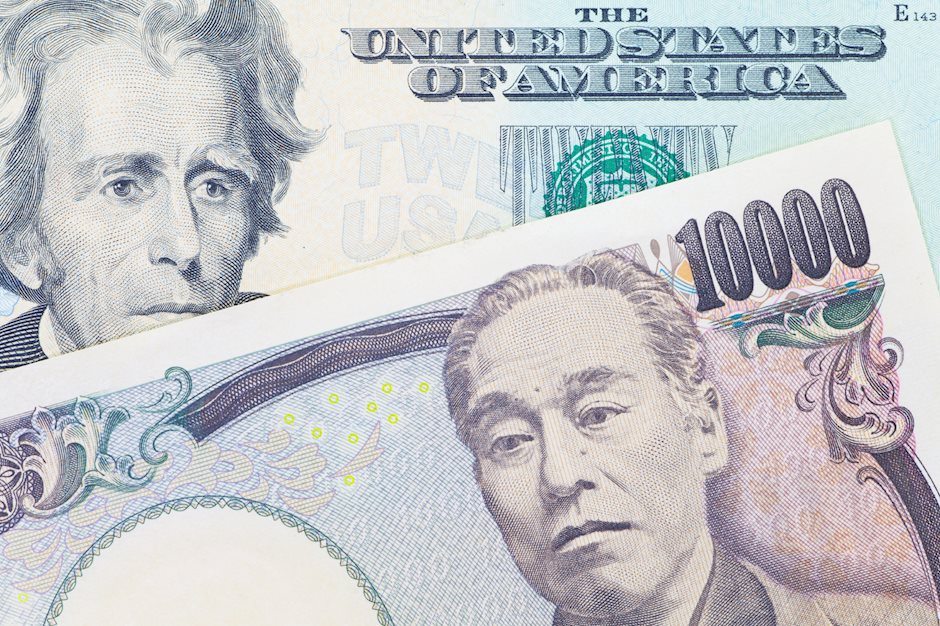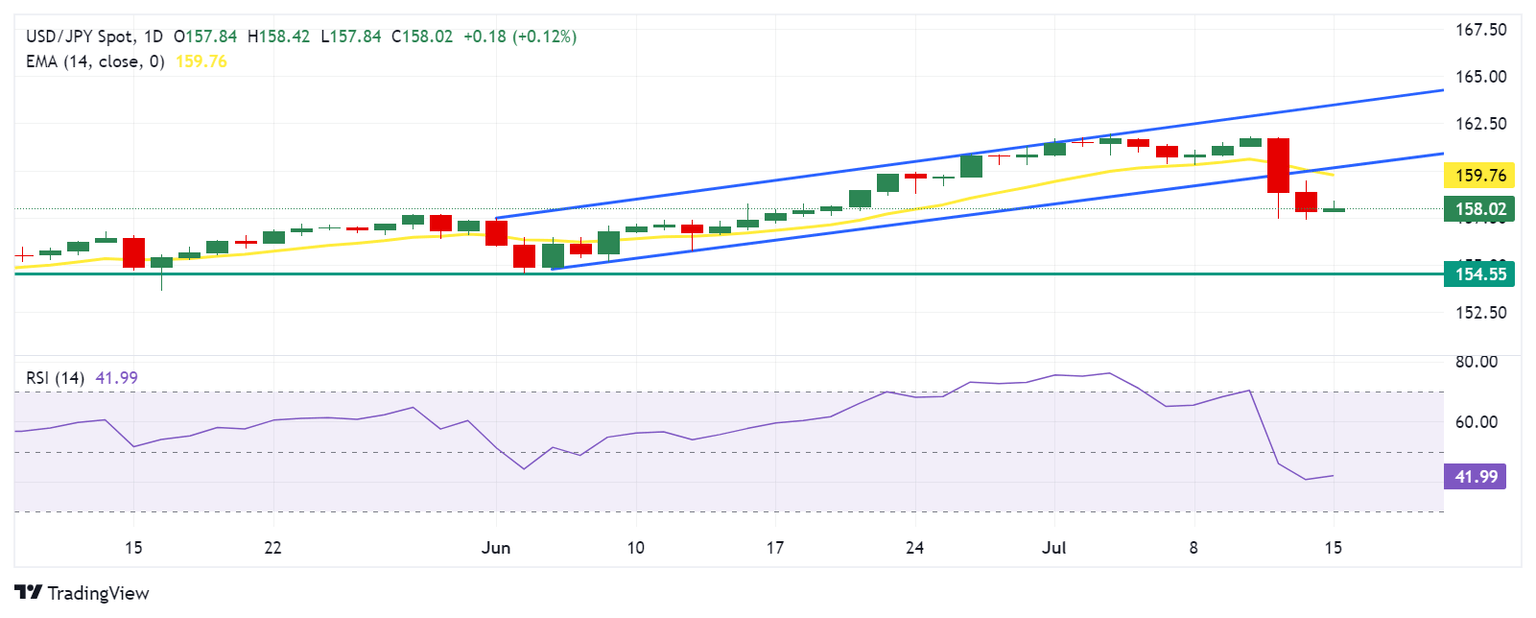Japanese Yen declines due to improved US Dollar, awaits Fed Powell's speech
- The Japanese Yen declines as the US Dollar improves due to the failed assassination of former US President Donald Trump.
- The JPY may experience volatility amid speculation about potential intervention by Japanese authorities.
- Japanese authorities are estimated to have expended between ¥3.37 trillion to ¥3.57 trillion to curb the rapid depreciation of the JPY.

The Japanese Yen (JPY) edges lower on Monday as the US Dollar (USD) strengthens amid rising risk aversion triggered by the attempted assassination of former US President Donald Trump on Saturday. Analysts speculate that if this event boosts Trump's chances in the upcoming elections, it may drive 'Trump-victory trades,' potentially strengthening the US Dollar and steepening the US Treasury yield curve, as per a Reuters report.
The Japanese Yen (JPY) could face potential volatility amidst speculation of intervention by Japanese authorities. According to data released by the Bank of Japan (BoJ) on Friday, it's estimated that Japanese authorities may have spent between ¥3.37 trillion to ¥3.57 trillion on Thursday to stem the rapid depreciation of the JPY, as reported by Reuters.
The rally in the Japanese Yen, which had been hovering near 38-year lows, began on Thursday as the US Dollar (USD) weakened following data showing a moderation in US consumer prices for June. This development has increased expectations that the Federal Reserve could cut interest rates as early as September.
According to CME Group’s FedWatch Tool, markets now indicate an 88.1% probability of a 25-basis point rate cut at the September Fed meeting, up from 72.2% a week earlier.
Daily Digest Market Movers: Japanese Yen could experience volatility due to intervention threats
- ING’s FX analyst Francesco Pesole observes that Japan’s Ministry of Finance has adjusted its FX intervention strategy. Following the soft US CPI print on Friday, the USD/JPY pair declined approximately 2%, a larger drop compared to other USD pairs. The increase in JPY futures volumes appears to align with indications of FX intervention.
- UBS FX strategists observe that speculative investors hold near-record short positions on the Yen. They suggest that if US economic data continues to indicate a soft landing, USD/JPY could experience periods of pullbacks.
- BBH FX strategists highlight that recent softness in US data poses challenges to their perspective that the backdrop of sustained inflation and strong growth in the US largely remains intact. They note increasing concern among Federal Reserve officials regarding weaknesses in the labor market.
- Japanese Chief Cabinet Secretary Yoshimasa Hayashi stated his readiness to employ all available measures regarding forex. Hayashi noted that the Bank of Japan (BoJ) would determine the specifics of monetary policy. He expects the BoJ to implement appropriate measures to sustainably and steadily achieve the 2% price target, reported by Reuters on Friday.
- On Friday, Japanese Finance Minister Shunichi Suzuki emphasized that rapid foreign exchange (FX) movements are undesirable. Suzuki refrained from commenting on FX intervention and declined to address media reports regarding Japan's FX rate checks, as reported by Reuters.
- On Thursday, the data showed that the US Core Consumer Price Index (CPI), which excludes volatile food and energy prices, rose by 3.3% year-over-year in June, compared to May's increase of 3.4% and the same expectation. Meanwhile, the core CPI increased by 0.1% month-over-month, against the expected and prior reading of 0.2%.
- Federal Reserve Chairman Jerome Powell highlighted the urgent need to monitor the deteriorating labor market on Wednesday. Additionally, Powell expressed confidence in the downward trend of inflation, following his remarks on Tuesday that emphasized the necessity of further data to strengthen confidence in the inflation outlook.
Technical Analysis: USD/JPY holds position around 158.00
USD/JPY trades around 158.00 on Monday. The daily chart analysis indicates a weakening bullish trend as the pair has broken below the lower boundary of an ascending channel pattern. Additionally, the 14-day Relative Strength Index (RSI) is below the 50 level, signaling a decline in the pair's momentum.
Further downward movement could exert bearish pressure on USD/JPY, potentially testing support near June's low at 154.55.
On the upside, immediate resistance is observed around the 14-day Exponential Moving Average (EMA) at 159.75, followed by the lower boundary of the ascending channel around 160.20. A return to trading within the ascending channel would likely improve sentiment for the USD/JPY pair, with a potential target toward the upper boundary of the ascending channel near 163.50.
USD/JPY: Daily Chart
Japanese Yen PRICE Today
The table below shows the percentage change of Japanese Yen (JPY) against listed major currencies today. Japanese Yen was the weakest against the British Pound.
| USD | EUR | GBP | JPY | CAD | AUD | NZD | CHF | |
|---|---|---|---|---|---|---|---|---|
| USD | 0.09% | 0.03% | -0.16% | 0.06% | 0.05% | 0.23% | 0.04% | |
| EUR | -0.09% | -0.03% | -0.07% | 0.14% | -0.00% | 0.33% | 0.13% | |
| GBP | -0.03% | 0.03% | 0.06% | 0.17% | 0.02% | 0.31% | 0.16% | |
| JPY | 0.16% | 0.07% | -0.06% | 0.20% | -0.02% | 0.35% | -0.00% | |
| CAD | -0.06% | -0.14% | -0.17% | -0.20% | -0.06% | 0.19% | -0.02% | |
| AUD | -0.05% | 0.00% | -0.02% | 0.02% | 0.06% | 0.33% | 0.14% | |
| NZD | -0.23% | -0.33% | -0.31% | -0.35% | -0.19% | -0.33% | -0.20% | |
| CHF | -0.04% | -0.13% | -0.16% | 0.00% | 0.02% | -0.14% | 0.20% |
The heat map shows percentage changes of major currencies against each other. The base currency is picked from the left column, while the quote currency is picked from the top row. For example, if you pick the Japanese Yen from the left column and move along the horizontal line to the US Dollar, the percentage change displayed in the box will represent JPY (base)/USD (quote).
Bank of Japan FAQs
The Bank of Japan (BoJ) is the Japanese central bank, which sets monetary policy in the country. Its mandate is to issue banknotes and carry out currency and monetary control to ensure price stability, which means an inflation target of around 2%.
The Bank of Japan has embarked in an ultra-loose monetary policy since 2013 in order to stimulate the economy and fuel inflation amid a low-inflationary environment. The bank’s policy is based on Quantitative and Qualitative Easing (QQE), or printing notes to buy assets such as government or corporate bonds to provide liquidity. In 2016, the bank doubled down on its strategy and further loosened policy by first introducing negative interest rates and then directly controlling the yield of its 10-year government bonds.
The Bank’s massive stimulus has caused the Yen to depreciate against its main currency peers. This process has exacerbated more recently due to an increasing policy divergence between the Bank of Japan and other main central banks, which have opted to increase interest rates sharply to fight decades-high levels of inflation. The BoJ’s policy of holding down rates has led to a widening differential with other currencies, dragging down the value of the Yen.
A weaker Yen and the spike in global energy prices have led to an increase in Japanese inflation, which has exceeded the BoJ’s 2% target. Still, the Bank judges that the sustainable and stable achievement of the 2% target has not yet come in sight, so any sudden change in the current policy looks unlikely.
Author

Akhtar Faruqui
FXStreet
Akhtar Faruqui is a Forex Analyst based in New Delhi, India. With a keen eye for market trends and a passion for dissecting complex financial dynamics, he is dedicated to delivering accurate and insightful Forex news and analysis.


















